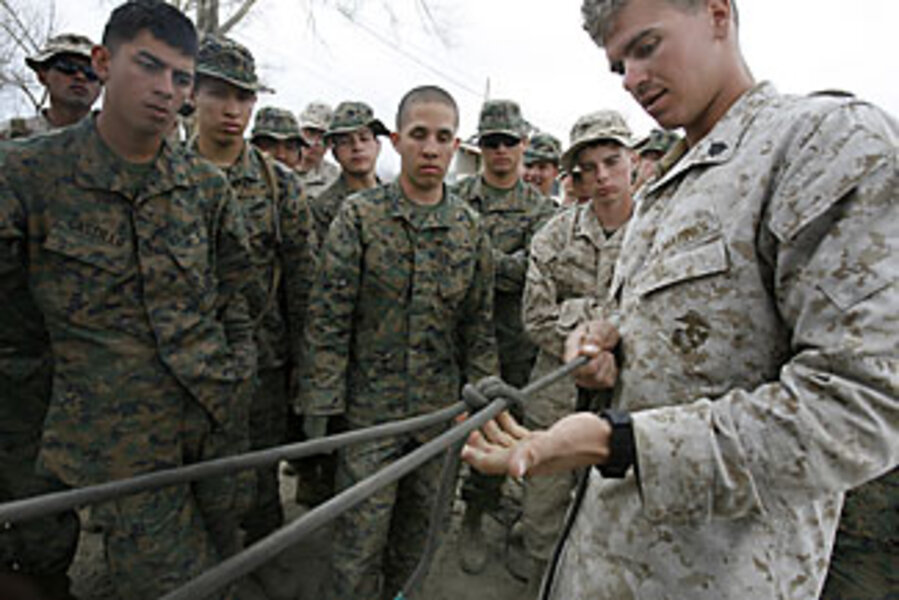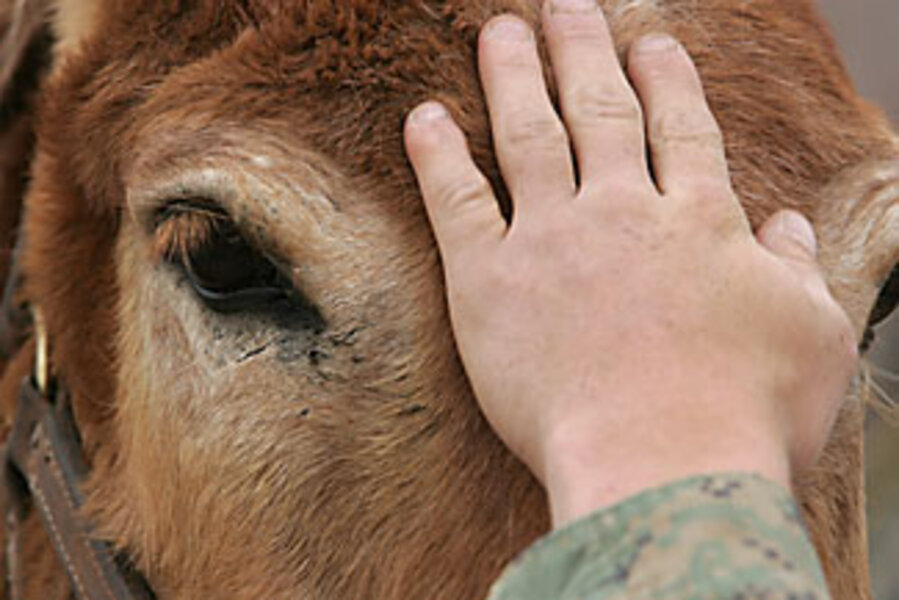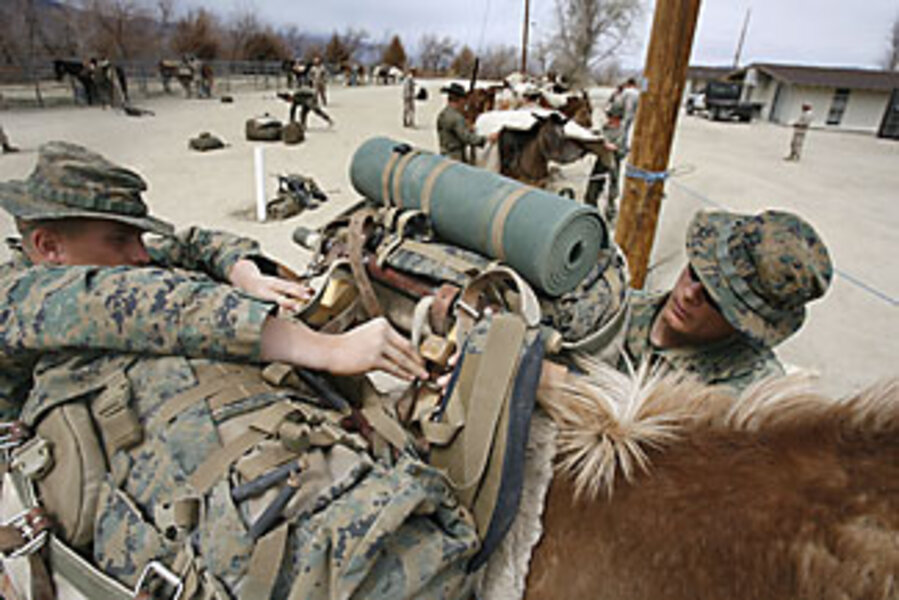Fighting a high-tech war with a low-tech mule
Loading...
| Bridgeport, Calif.
Tucked at the base of a small mountain in the eastern Sierras is a makeshift paddock where a handful of US Marine Corps instructors reach deep into the history of warfare to give their charges a critical skill when they deploy to Afghanistan: how to pack a mule.
It is a peculiar course to teach in a military that is widely considered the best-trained, most capable, and highest-tech in the world.
But as the US girds to deploy more than 21,000 additional troops to Afghanistan this spring and summer, the military is having to prepare for a decidedly different kind of fight from the one in Iraq.
The American military experience during the past several years has been so defined by the Iraq war that many combat-hardened troops have never deployed to Afghanistan. The shift requires personnel from grunts to generals to tap into unique forms of know-how and to relearn the counterinsurgency lessons of Iraq in a new context.
The differences between Iraq and Afghanistan are striking: Afghanistan offers more complex linguistic and cultural challenges, a more sophisticated and perhaps determined enemy, and a rugged mountain terrain that is among the most forbidding and remote landscapes anywhere in the world.
Afghanistan's rural insurgency is far removed from the urban-based fighters in Iraq. The Taliban in Afghanistan tend to operate in larger groups than the terrorists who planted roadside bombs to attack American forces in Iraq.
The cultures, while both Islamic, are also vastly different. In addition to being predominantly Sunni (unlike the mostly Shiite Iraq), Afghanistan has a rich layer of tribes, ethnicities, and other cultural and linguistic groups that require American forces to have a far more sophisticated understanding of their "area of responsibility."
Marines operating in Iraq's Anbar Province, for example, worked in a fairly homogeneous Sunni region. But in Afghanistan, one tribe can live a valley away from another tribe but speak a different language. These tribes often have distinct motivations and deep-seated suspicions of each other.
"Afghanistan offers a different problem completely," says Terry Walker, a retired Marine Corps chief warrant officer who trained Iraqi forces in Anbar and is now training the military in the US for both fights. "Afghanistan has never known anything else but tribalism – and of the worst stripe."
More immediately obvious upon arriving in Afghanistan are the extreme terrain and climate. While Iraq is known for its stifling summer heat and mostly broad desert plains, Afghanistan offers low deserts and rugged mountain ranges with high-altitude cold. That means changing the training troops receive.
For example, helicopters can have difficulty flying at Afghanistan's higher elevations – between 5,000 and 14,000 feet. The altitude makes it tougher for helicopters to carry heavy loads, and engines need more fuel to run in the thinner mountain air. Pilots must learn a new set of techniques.
The nature of the enemy threat, too, is different. The Taliban use small arms and rocket-propelled grenades to target helicopters. That means pilots must fly higher in Afghanistan than they do in Iraq, where the main weapons used against US troops are roadside bombs and attacks against helicopters are less frequent.
Afghanistan's high altitude can have a withering effect on even the most fit marine or soldier. Sgt. Scott Moss, who teaches mountain sniping techniques here, tells students to do leg and lung conditioning prior to deployment.
Heavy loads, like packs of 70 pounds or more, can be extremely difficult to carry during the first two weeks in a high-altitude environment, he says.
"Ounces equal pounds, and pounds equal pain," says Sergeant Moss as he stands in the middle of a mountain road here.
ENTER THE MULES. In a place as demanding as Afghanistan, the military must look at "sustainment" – the resupply, care, and feeding of the force – in a new way. The result: mule school.
Some of Afghanistan's high terrain is so inhospitable that helicopters can't fly to forward bases. Yet, working among the populace is crucial to a successful counterinsurgency campaign. Since the workhorse of the military, the Humvee, can't cross many mountain passes, mules are the best alternative, officers say.
It is here at the Marine Corps's Mountain Warfare Training Center, where marines and other troops are schooled in sniping, navigation, packing an animal, and survival – including careful instruction on how to eat a goat.
"Long-haul sustainment," says Col. Norm Cooling, who runs the center, "means you've got to leverage things on one end of the spectrum, like animals, all the way to the other end of the spectrum, like GPS-guided combat delivery system drops from fixed-wing aircraft.... What [logistician] was ever taught to do that?"
Bridgeport, in the eastern Sierra Nevada near the Nevada state line, most nearly replicates the high-altitude terrain troops will encounter in Afghanistan.
With its chaletlike buildings, hunting motifs, and snowcapped mountain backdrop, the base has earned a reputation within the military as a "ski and climb club" for those fortunate enough to win assignment here.
But many say that belies its value as a US-based training facility almost uniquely suited to the complex terrain of South Asia. It is the ideal location to offer the Animal Packing Course, a two-week program in which students learn the fine points of mule packing.
Patrick Kinser, a young Marine captain who has been in Iraq twice and Afghanistan once, oversees formal training here. With a confident, can-do attitude, Captain Kinser says animal-packing skills are highly valuable.
"The most responsive and reliable form of sustainment I had in Afghanistan was hiring local animals," says Kinser.
"It is essentially a lost art because no one really teaches it," he says during a recent drive through the training base. "Except for us."
Kinser was driving a white hybrid SUV across a vast valley to get to a sleepy former Army post where the terrain most closely resembles Afghanistan's physical features.
Sweeping prairies covered with sweet-smelling sagebrush and juniper push up steep inclines to 12,000-foot peaks. At the base, a group of four instructors teach the animal-packing class to about 50 marines and soldiers preparing to go to Afghanistan.
The mules and a handful of donkeys – smaller than the horse-sized mules more likely to be found in Afghanistan – are lined up as the students prepare for their first, two-mile "hump" with the animals.
The teams of students each take an animal and begin to load them with various pieces of gear, carefully tying their loads with an elaborate series of box, basket, and barrel hitches before covering them with white tarpaulins with "USMC" stamped on the side.
Animal packing has been used since the days of Genghis Khan and Alexander the Great, and it is a skill outlined in the Marine Corps's Small Wars Manual, its tactical bible.
Mule packing first returned as a US military skill in the 1980s during the Soviet invasion of Afghanistan, when the CIA purchased about 10,000 mules to help the Afghan mujahideen repel Soviet forces. Many of the imported mules died, unable to survive the extreme conditions there. But the Soviets ultimately failed, in part because they were never able to break the Afghan supply lines – largely comprising pack mules.
The animal-packing course has been offered here ever since. It was formalized more than a year ago and it's expected to become more popular this year as more forces prepare for deployment to South Asia.
"If you can balance a load and tie a half hitch, you can pack a mule," says Anthony Parkhurst, the packmaster here. "It's not rocket science, or I wouldn't be doing it."
The instructors take care to give students an appreciation for each of the animals so they will know what to do when they use indigenous donkeys in-country.
Sgt. Jerry Meese, a former bull rider who is the instructor-leader, has deployed to Iraq three times, although never to Afghanistan. But he knows well the animal-packing course he teaches and he says the skills that troops learn here are important.
"If you start relying on modern technology too much," he says, "there will come a time when people will forget how to do this." •







